Illinois Alums Laguna and Zuzuly Encourage Freshman Engineering Women During WIE Orientation
“You can change the world. You have the opportunity to change the world by going into engineering.” – Ann Zuzuly

Ann Zuzuly and Val Laguna at WIE Orientation 2019.
October 23, 2019
BFFs. Best friends forever. Even though Illinois alums Val Laguna and Ann Zuzuly graduated from Mechanical Science and Engineering six years ago, the close friendship they developed while here at Illinois is still intact. And though they now live and work several states apart, they still get together periodically to catch up. One of those times, probably the highlight of the summer for both, was coming back to their old stomping grounds to co-present as Keynote Speakers at the 2019 WIE Orientation in late August. There they had a chance to catch up with some old friends, encourage the next generation of women engineers, and possibly even recruit a few to their current companies as well.
Ann Zuzuly and Val Laguna met at WIE (Women in Engineering) Camp (which has since become WIE Orientation) back in fall 2009 when it was an overnight event at Allerton Park. The two were part of the same small group the first night of camp. By their junior year, Ann and Val were roomies. In their senior year, they served as co-coordinators of WIE Camp. After graduation, Ann got a job at Eaton, which deals in power management technologies. Val works at Procter and Gamble (P&G), which makes household products we use every day, such as laundry products, shampoo, toilet paper, etc.
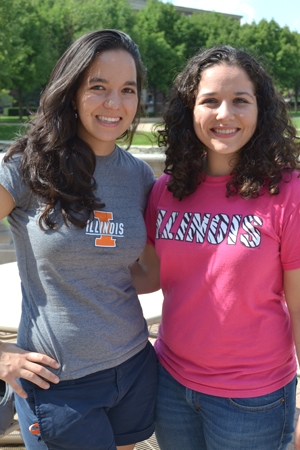
MechSE seniors Val Laguna and Ann Zuzuly in fall 2012
When the two were invited to come back to campus to give the Keynote Address at WIE Orientation, plus represent their companies at the brand-new Company Fair, the two jumped at the chance—mostly because of what the event had meant for them as freshmen.
“I loved WIE orientation,” reports Ann. “It was so foundational for me, for meeting my friends group, meeting my study group…It had such an impact on me in college that I wanted to make sure that this group of freshmen had that same opportunity.”
Val’s reason for wanting to return was similar. “I remember WIE orientation so fondly,” she explains. “Again, so foundational, so instrumental to my time here. And those friendships that I developed were my crutch through all of college and have now become such amazing peers and a great place to look for advice.”
Coming back for Orientation was also special because the two coordinated it as seniors. “It brings it full circle,” adds Val. “So I was part of it as a freshman. I got to lead it as a senior, to make sure that it was a really fantastic experience. Because it was for us, and I wanted it to be for somebody else, and to be able to be a positive influence and positive light.”
Of course, being keynote speakers allowed them to speak into the lives of incoming freshman women, possibly having a positive influence on their entire careers at Illinois. Also, recalling what it was like to be freshmen soaking in sage advice, they were delighted to give back.
“As we were writing that presentation,” Val recalls, “I just kept thinking, ‘What did I want to hear as a freshman?’ And the fact that I can be in a position to be that person—to be the person to provide some insight and advice is so amazing, and it's humbling, and I can't help but take the opportunity.”
Co-presenting also made it extra special. “To be able to do it with Ann…” says Val. “I love that we had this opportunity to do it together,” Ann agrees. “Yeah. I mean, we met that weekend, at WIE Orientation.”
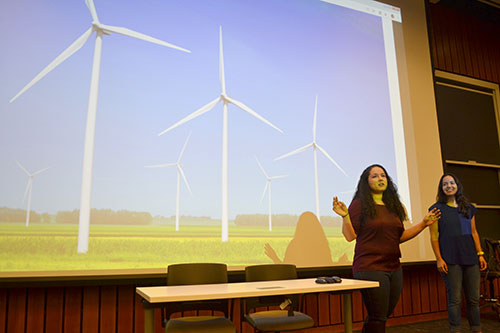
Ann Zuzuly (left) describes some of her company’s work in power.
The two were quite pleased to see the way the event has grown. Regarding the 350 girls, the most ever to attend WIE Orientation, Val claims, “That’s super exciting for us, too, to see that growth…For Angie to say that we don't fit in any of the classrooms, that's so cool!”
Although their keynote was chock full of good advice for the freshman girls, they recap here what they believe to be their most important advice for the freshmen. Val says these two ideas were their keynote in a nutshell: “Mine was ‘Take power; you have control.’ And hers [Ann's] was, ‘Find what you like, what you don't like.’”
So Val’s counsel, which she admits to putting into practice in her own life, is this: “The idea that you choose to be happy. You have so much control over how things affect you every single day.” Acknowledging that this principle was something her mom tried to teach her growing up, she says it solidified into a life habit during college. For example, when going through a tough time, “Instead of letting that experience demotivate me,” she’d tell herself, “’I'm going to use this as a springboard to do better, to understand where my strengths are.’” She claims her strengths back them were all the extracurriculars she got to plan. “I work in management, right,” she adds, “because that's what I'm good at.”
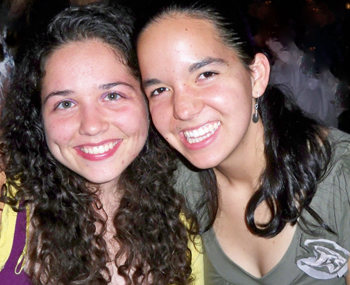
Val and Ann during their sophomore year at Illinois.
She reiterates what she considers to be her biggest piece of advice: “You have so much control over how things affect you, and decisions, and the things you go do every single day. So go find the resources so you can do what you want to do, to take that control. You choose to be happy; it's in your control.”
Ann’s advice is more focused on experimentation: “Try things to see what you like. There are so many different things. You might have an idea of what sounds interesting, but until you try it, you don't know if you like it, and you need to find what it is that makes you happy and what it is that you like in order to really, really know what you want to do and be successful.” Explaining that freshmen will have so many different options from which to choose, and so many opportunities to take advantage of, she encourages them to “Understand what it is that makes you tick and gets you to where you want to be.”
Agreeing with Ann, Val borrows one notion from her friend to add to her previous advice: “You choose to be happy, but go pursue things that make that choice easy. What you’ve got to do is find what you like and don't like.” Adds Ann: “It's okay if you don't know what you want to do, just do things to figure out what you want to do.”
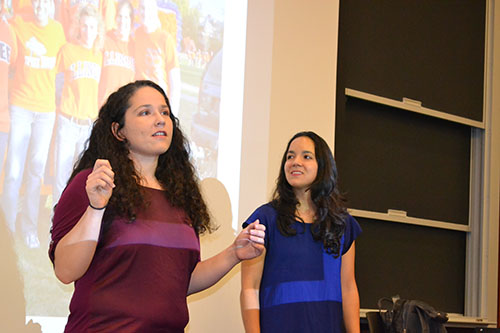
Ann Zuzuly and Val Laguna present their keynote presentation during WIE Orientation.
Having had several years to ruminate since they were students at Illinois, the girls shared one of the most important things each had learned. Val says her answer wasn’t what it would have been when she graduated, acknowledging that it’s something she’s realized since she’s been gone: “The balance between rigor and efficiency,” she states. She recalls that when in school, she had all these things that she wanted to do—all the extracurriculars—but also all the academics that were really important and building incredible foundations. “And the way to be successful was, you had to be rigorous. You had to do these things, right? You had to understand them. You had to deliver good work, but you needed to be also efficient and effective in the way you got that work done.”
She cites a scenario. Suppose she had already spent six hours doing a homework assignment, had 80% of it done, then spent four hours finishing the final 20% of her homework. “The ratio doesn't match, right?” she asks. “Was that worth it? I didn't realize how many choices I made while in college to try and be rigorous but effective.”
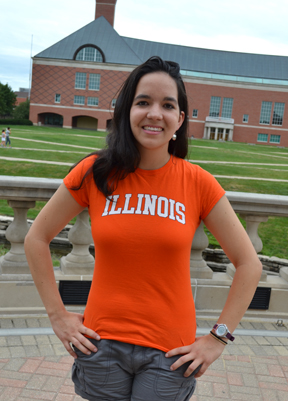
Mechanical Sciences and Engineering senior Val Laguna
She explains how that skill has transferred over into her career. “And I feel like that skill is what makes me really successful at my job,” she adds, indicating that when she delivers data extremely quickly—good data that her colleagues can drive decisions off of—that enables them to make decisions very quickly as well. “Then people appreciate me, right?” she adds. “They say, ‘You lay things out so well, and it allows us to move forward very quickly, and I can make decisions and immediately evaluate risk.’”
Val describes her thought process in rigorously evaluating every single option. “What happens if I do this?” she asks herself. “And I'm thinking of every option imaginable. But again, I learned in school to be rigorous, right?” She recalls lab reports where she had to make sure she understood what she was talking about, and homework where she was trying to figure out how to solve a problem. There were lots of variables that she was looking for to try to make something happen.
“You had learned all these things,” she recalls, “and you're like, ‘Okay, out of everything that I learned, how do I solve this problem in front of me?’ So you go through your bank of knowledge and you're rigorous in how you execute work and the fact that you can be rigorous very quickly makes you very effective.”
Ann claims the most important thing she learned was agility. “If you can figure out how to navigate the University of Illinois, that will help you navigate the workforce. So if you can figure out where the resources are to make you successful, there will be similar resources at work for figuring out ‘Who is the Goto?’ and ‘Where is the information located?’”
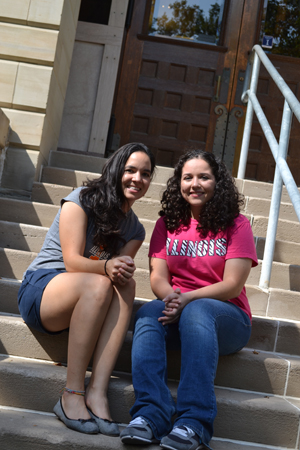
Val Laguna and Ann Zuzuly on the steps of Engineering Hall in September 2012.
Ann confesses that she’s earned the nickname Zoogle at work. (shortened from Zuzuly Google). “Basically it's because if you want to know who the Goto is, where the information is, I can tell you exactly where it is for pretty much everything. And a lot of those skills that I learned were from Illinois.” For instance, when here, she was able to figure out what it is that everyone does and what they care about—in the Dean's office, different student organizations, different recruiting groups, even with the teaching assistants (she managed the Engineering 100 course). “If you can learn that skill set,” she continues, “you will be super successful for the rest of your life.”
Currently a Lead Software and Controls Engineer at Eaton, Ann shares how her Illinois education helps in her job. “The training at Illinois gave me a really strong technical foundation across multiple skill sets. So I work at the intersection of mechanical engineering, electrical engineering, and computer science. Because I was able to take classes in all of those areas and develop the skills in all of those areas, it enables to me to be successful at my job.” While other schools might not offer cross- functional classes, the fact that at Illinois, she could take a lot of different classes in a lot of different technical areas, has been hugely beneficial for her career.
Val’s position at Procter and Gamble is the Fabric and Homecare Material and Process Delivery Leader; she’s in process delivery at the intersection between research, development, and operations.
“So it's a really cool place to be,” she claims. “Research development comes up with what they want to go do and how they plan to go do it from a feasibility standpoint. Then I go implement it at the plant and prove that it meets the specifications that research and development came up with. And then once we’ve proved that, we hand it off to operations who actually runs it every single day.” For instance, P&G is starting up a brand new plant in West Virginia, so she has to go check that all of the equipment is working the way it's intended.
.jpg)
Ann Zuzuly and Val Laguna proudy display the Women in Engineering Champion awards they received at WIE Orientation.
She recalls that at Illinois, she gained the ability to be really agile and dynamic while taking multi-disciplinary classes. “But then that also means that your brain is switching between, at a very simple level, the physics homework versus the chemistry homework versus a fluids class. It's just different thinking, different ways of thinking.” She even took a financial class which is important in their line of work as well. For example, if a process is very time consuming or wastes a lot of materials, it’s not cost effective.
“Because too we got a mix of very hands on and theoretical,” adds Ann. “That combination gives a really good foundation for just being a really strong engineer.”
Val agrees, saying it goes back a little bit to the rigor effect, claiming that as a senior or during her first year on the job, “I would not have told you I have amazing engineering foundations,” she says. “It comes out five years later. My ability to really effectively solve problems all because my foundations are so strong. Because of my Illinois education, I can very quickly come up with the data that I need to solve problems.”
There’s another reason Val and Ann were excited to return to their Alma Mater to encourage young women in engineering. The two are passionate about increasing the number of women in engineering. And evidently it’s important to their companies, too.

Val Laguna and Ann Zuzuly by the Mechanical Engineering Laboratory during their recent visit to Illinois..
“Women are 50% of the population,” Val explains, “so ideally we should be 50% of the incoming class.” In the same vein, women should be 50% of every industry. However, she still sees studies and statistics about women in STEM and considers it to be untapped potential.
“When we have women that could have been engineers that are not engineers, we are losing out on untapped potential,” she claims. “The whole industry is losing out on what somebody could have offered. So, to me, it's important that we continue to drive confidence in the ones that have chosen engineering, and that they've made the right choice, and that they deserve to be here. I want to help drive that confidence.”
Plus, she asserts that as the number of women in engineering continues to increase, they can serve as role models for the younger generations to see engineering as normal. For instance, while Val is flattered every time she tells someone she’s an engineer, and they say, “Wow!” or “Oh!", she’d like to see that change. “Every single time,” she reiterates. “And it makes me feel really cool—don’t get me wrong. But, it'd be awesome if [women in engineering] were more normal.”
Ann adds that since “women are 50% of the population,” therefore “the products that engineers develop…50% of them are used by women.” She claims it’s important to have women on the team designing the product in order to give a woman’s perspective, then gives an example from the auto industry: the Hummer.

Val and Ann with fellow classmate Mark Figge during the Engineering Open House their freshman year.
“They did product testing, and there were complaints that, ‘Oh, I don't have anywhere to put my purse.” Ann claims that there should have been a woman during the design phase of it going, “’Hey, what are the things that our people are looking for?’ and providing 50% of the population’s perspective. That has a huge impact on what the design ends up.”
“Our workforce has to represent the consumers that we serve,” Val agrees. “And P&G says that all the time. And that's what drives our diversity and inclusion.”
Regarding recruiting more women, Ann admits, “Engineering doesn't always do the greatest job of marketing themselves to prospective students.” She claims most people, including young students, don't really know what engineering is. They just think, ‘Oh, you need to be good at math or science, and that's what engineering is,’ but don't really know what that means.
“It's problem solving…It's making an impact…solving world problems,” she states, then goes on to list some of the things engineers do, like making the grid more efficient, having an impact on the environment, or coming up with pharmaceutical solutions. “There's so much of an impact,” Ann continues. “They're saving lives. And if you don't frame it in that perspective, people don't realize how cool it is, all the things that engineers do.”
Val calls recruiting women into engineering “a big marketing opportunity.”
“Yeah!” Ann agrees, then comes up with the perfect slogan: “You can change the world. You have the opportunity to change the world by going into engineering.”
Story and photos by Elizabeth Innes, Communications Specialist, I-STEM Education Initiative
More: Engineering, MechSE, Illinois Legacies, WIE, Women in STEM, 2019
Additional photos courtesy of Ann Zuzuly and Val Laguna
For additional I-STEM articles about WIE Orientation, see:
- Fall 2019 WIE Orientation Introduces Engineering Freshmen Women to a Support System, Possibly Life-Long Friends (WIE 2019)
- From WIE Camp to Seniors: Two Future Engineers Credit Illinois' Community of Support (2012 article about Val & Ann)
- Freshman Women in Engineering Get Ahead of the Curve At WIE Orientation (WIE 2018)
- Engineering Freshman Women Get Familiar With Campus, Learn About Illinois Resources, and Build Community at WIE Orientation
- At WIE Orientation, Engineering Freshman Women Experience Campus, Build Community
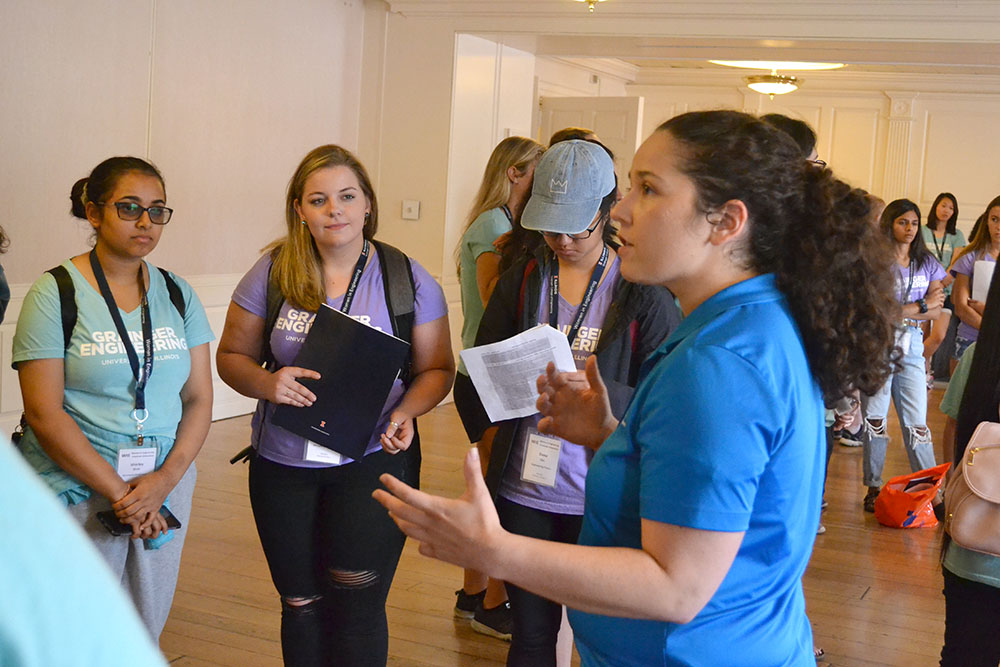
Ann Zuzuly shares about her company, Eaton, during the Company Fair.













.jpg)
















